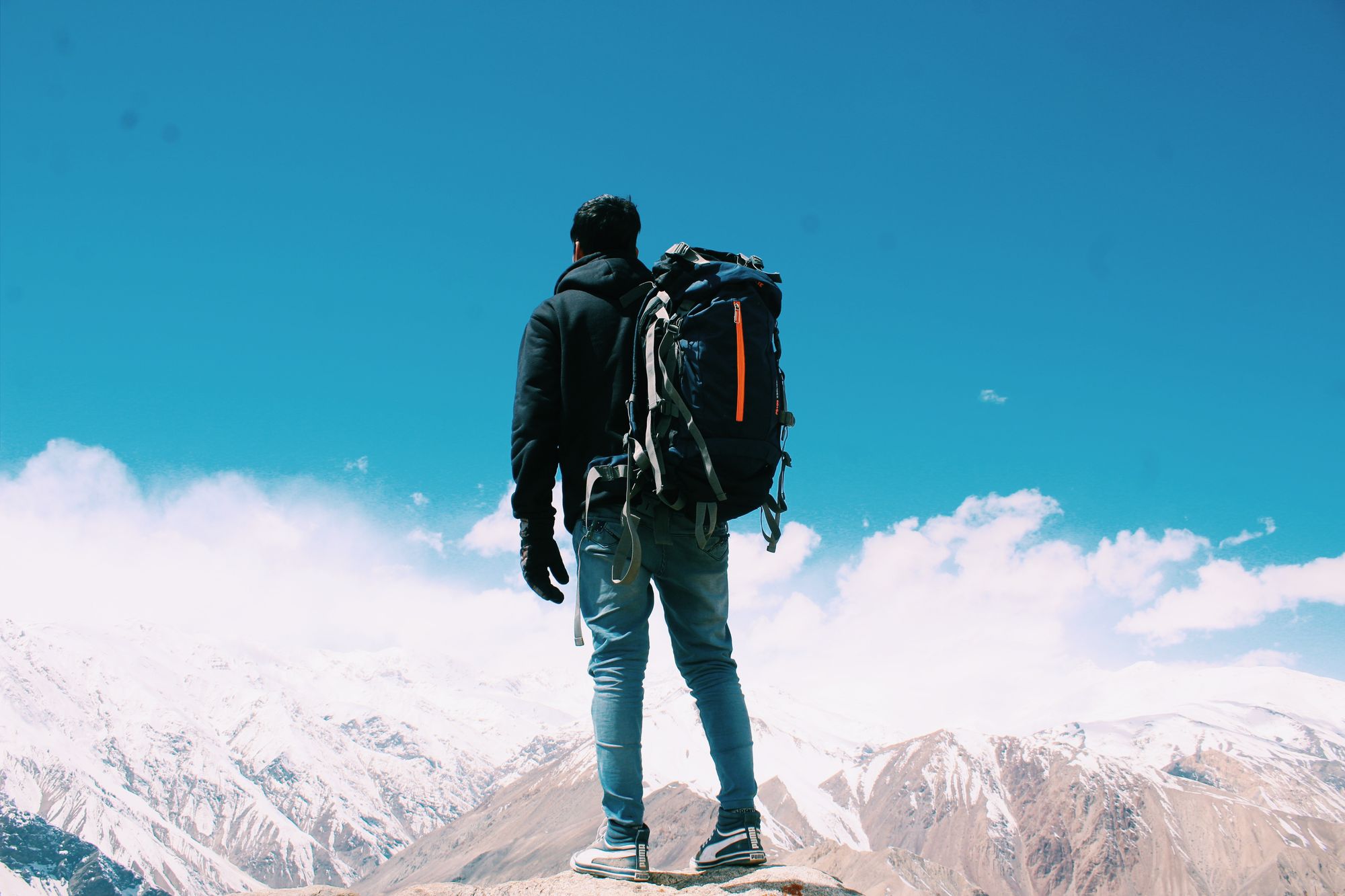
Some people don’t pack safety backpacks full of safety and emergency items for a hike, because of the excess weight. Safety backpacks, however, could save you or another person on a hike who needs what you’ve packed.
If you’re going on a winter hike with a group of people, you could always take turns carrying the safety backpack if it’s heavy.
Hiking and snowshoeing in the winter are very healthy and scenic winter activities. Just because the temperature drops, the cold winds blow, and snowcaps form on mountains, doesn’t mean hiking is off-season. If you’re looking for creative outdoor activities this winter, building a snowman, ice skating, sledging, or tubing are not the only options. You can go on a beautiful winter hike to enjoy breathtaking views and get some good exercise.
Imagine snowy meadows, pretty icicles on branches, frozen ponds, and trees blanketed with snow. Take advantage of the nearby trails in winter to encounter fewer crowds, revel in peaceful solitude, and enjoy more of the majestic atmosphere. Going on a hike is a great cardio workout to get your heart rate up, improve your cardiovascular endurance, and improve your overall health. Safety backpacks simply ensure you’re safe out there on your winter hike.
Best of all, studies prove that earthing or communing with nature helps improve your mood, alleviates stress, and promotes better sleep by enhancing the body’s circadian rhythm. Clearly, a good hike is just what you need to kick off the winter blues. But before you set off to enjoy the fresh air and the resplendent icy wonders from nature, you have to prepare ahead.

The Importance of Safety Backpacks
Hiking in winter is totally different from summer because winter excursions pose extra challenges with the frigid temperatures, especially if there’s snow. Extra safety precautions have to be taken in the winter if you’re going hiking. This is why safety backpacks in the winter will typically weigh a bit more than safety backpacks in the summer. Without proper preparation, you can get stranded or encounter hypothermia, avalanche threats, dehydration, and other accidents. Apart from wearing appropriate water-proof and weather-proof clothing, gloves, mittens, scarves, bonnets, and shoes, you must carry safety items in your backpack. And of course, don’t forget your microspikes and poles to help you with your hike.
In the summer, you can get by with a minimalist gear set to let offload the weight. But in winter, it is vital to err on the side of caution, especially since there’s a greater chance that you will encounter high winds, rain, sleet, snow, and bitter cold in the wintertime. Preparing for the unexpected gives you control and peace of mind to ensure you survive until you can make your way back home. Check out these safety items you should carry inside your safety backpacks on a winter hike:
Map and Compass
Although you may have a watch equipped with GPS and other devices, you’re not sure about the signal once you get deeper into the trail. Besides, it’s easy to lose your way in winter because trail blazes and guides are hidden under a blanket of snow. It is possible to see fewer landmarks when everything around you is white. Having an old-school map and compass will ensure you don’t lose your way. Think of them as a backup in the event your electronic devices fail.
Whistle
In winter, you have to make sure that you’ve got a plastic whistle. A metal whistle is a conductor so it will be very cold. When you put it on your lipids, it can freeze and burn your sensitive mucous membranes. A plastic whistle is useful in case you get lost. The piercing sound it creates is much louder than the human voice. Besides, you will wear yourself out screaming. But blowing gently on a whistle will not exhaust your vocal cords.
Packing a whistle could help someone find you if you’re immobilized and injured.
Headlamp, Flashlight and Lithium Batteries
Never leave for a winter hike without a headlamp and a backup form of light inside your group’s safety backpacks. Bring an extra pack of lithium batteries and make sure your headlamp and other electronic devices are equipped with this variant. Lithium batteries are highly resistant to cold temperatures so you can expect better longevity. In contrast, alkaline and nickel-metal hydride batteries drain power so much faster when it is frigid outside.
First Aid Kit
Whether it’s summer or winter, you must always have a first-aid kit in your backpack. You can buy one in-store or assemble one yourself. Check out the complete anatomy of a first aid kit from the Red Cross organization. Apart from the usual bandaids, pain relievers, antiseptics, etc., your kit must have a multipurpose tool and plastic ties during winter. This can help you repair gear that suddenly gives out because of the frigid weather. Plastic tends to be more brittle in winter so it’s best to be prepared. On top of that, don’t forget to include sunscreen because harsh rays can break the cloud barrier, and you can still get sunburn from light reflected off the snow.
Avalanche Safety Solutions
Depending on where you live or what hike you’re doing, safety backpacks should include avalanche safety solutions. Your local outdoor education store could help guide you on what to buy. Perhaps it’s avalanche airbags or avalanche transceivers that should go inside your group’s safety backpacks.
Spare Hat and Gloves
It would be a very good idea to have a spare hat and gloves during winter. Most of your body heat escapes through your head. So in the event that your current one gets moist, you can change it to conserve internal heat. Similarly, you want to prevent your fingers from getting frozen because it will impact your hand mobility. You need a strong grip to carry on with your hike.
Extra Insulation
Packing a sleeping bag and pad will proffer extra insulation in case you are suddenly immobilized, stranded, or have to stay where you are. You must never forget this in winter because it can help you survive through the bitter cold until emergency help arrives. For example, a 20-degree sleeping bag with a foam accordion pad offers sufficient insulation. And it’s fairly lightweight so you won’t feel as if you’re carrying a ton of bricks.
Spare Layers of Warm Clothes
In the wintertime, it is essential to pack an extra set of full clothing. Select lightweight clothes that provide heat. You need this on standby inside the backpack in case of emergencies. If you are injured and cannot move much, your body will cool off the moment you stop moving. Hence, you need to bundle up even more to conserve your body heat.

Enough Food For 3 Days
Never go on a winter hike without food in your backpack. In winter, having this with you can spell the difference between life and death if you encounter an emergency. Always prepare for any eventuality. Having ready-to-eat food means you can fill your stomach and refuel your body with nutrients. This will allow you to stay energized to finish the hike. The best ones to take during winter are:
- Trail mix
- Nut and seed bars
- Energy bars or gels
- Freeze-dried fruits and veggies
- Tuna or chicken pouches
Tiny Stove and Cookpot
If you encounter an unexpected night out, having a tiny stove and cookpot in your pack means you can melt snow to create drinking water. Alternatively, you can carry solid fuel tablets and a simple metal cup if weight is a problem. And, of course, waterproof matches are essential for lighting up these babies. Again, you need waterproof in winter to make sure they light up. These aforementioned tinier gadgets will help you melt snow into drinking water and provide some heat in case of an emergency. Notably, if you are dehydrated, the onset of hypothermia accelerates. So pay attention to your water intake during a winter hike to avoid deadly consequences.
Extra Water: A Hydration Pack
You should have enough water for 3 days in case you’re stranded. Never leave home without water to avoid dehydration and prevent hypothermia. Most hoses in a standard hydration pack tend to freeze during wintertime. Thus, it is better to carry two to three 1-litre water bottles with you. Choose the wider mouth ones as the narrow version also tends to freeze shut because of their exposure to the harsh cold. You can also buy insulated water bottles meant for winter to prevent the water from turning into ice.
Before embarking on a winter hike, make sure you check the weather conditions. It would be frightening to get lost in the pouring rain. The priority is to stay warm and dry so you can enjoy your hiking trail. Since winter weather can be temperamental, if the weather turns unexpectedly sour during your hike, consider turning back. Your safety is the utmost priority.
Perhaps your group’s safety backpacks will include even more safety and emergency items than this list. Do some research and figure out which exact safety items are most important, given the terrain, conditions and weather of where you’re hiking.
If you’re curious about what type of exercise suits you best based on your DNA, check out the fitness reports from CircleDNA.







Comments are closed.